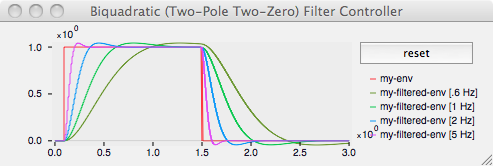Biquadratic (2nd Order IIR) Filter
Description
Filters its inputs by a second order IIR (Infinite Impulse Response) filter controlled by a set of 5 coefficients

Syntax and Default Values
The biquadratic-filter controller can be created using the following Mlys (Max), mlys.lua, or Lisp syntax:
In Modalys for Max, this object is named mlys.biquadratic-filter:

An input controller must be connected to the first inlet.
The dimension is automatically the same as the input controller.
💡If a second inlet is given, you can connect a 5-dimensional controller encapsulating the 5 coefficients of the filter. Otherwise a dynamic controller will be created automatically.
modalys.create_controller{kind="biquadratic-filter",
coefficients={1,,4.2,2.3,0.,1.5},
input=<controller of any dimension>,
name="MyBiquadraticFilter"}
The dimension is automatically the same as the input controller.
The coefficients parameter can be a 5-dimensional controller, but if passed as a table of 5 values, it can be changed dynamically via Max messages withMyBiquadraticFilter@coefficients
(make-controller 'biquadratic-filter
dimension
coefficients
input)
The dimension parameter must be the same as the input controller's dimension.
Parameters
- dimension: number of dimensions of the input and output controllers (automatic for mlys.lua and Modalys for Max).
- coefficients: a 5-dimensional controller specifying the 5 bilinear filter coefficients.
- input: filter input (a controller, possibly multi-dimensional).
The coefficients controller should have 5 dimensions which represent the a0, a1, a2, b1 and b2 coefficients.
This controller is updated at every sample (period = 0).
Discussion
This filter implements a general second-order (two-pole two-zero) filter which can be used for a variety of purposes, including smoothing out envelopes, and filtering sound-file, signal or other controllers. The following example is shown in one of the graphs (with a 1 Hz cutoff) in the above image:
(setq sp (get-info 'sample-period))
(setq my-env (make-controller 'envelope 1
(list '(0 0.0) '(0.1 0) (list (+ 0.1 sp) 1) '(1.5 1) (list (+ 1.5 sp) 0)) ))
(setq cutoff 1)
(setq Q 0.707)
(setq w0 (* cutoff 2 pi sp))
(setq alpha (/ (sin w0) (* 2 Q)))
(setq cw (cos w0))
(setq b0 (/ 1 (+ 1 alpha)))
(setq a0 (* b0 (- 1 cw) 0.5))
(setq a1 (* b0 (- 1 cw)))
(setq a2 a0)
(setq b1 (* b0 (* -2 cw)))
(setq b2 (* b0 (- 1 alpha)))
(setq my-filtered-env (make-controller 'biquadratic-filter 1 (const a0 a1 a2 b1 b2) my-env))
★